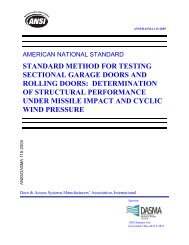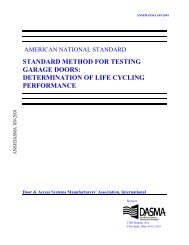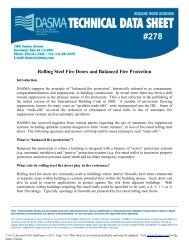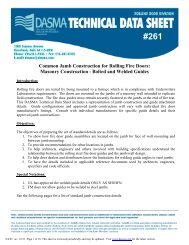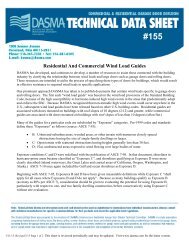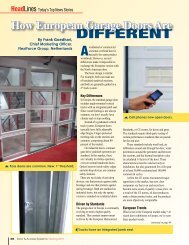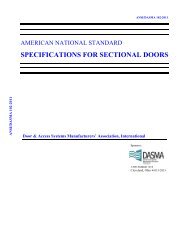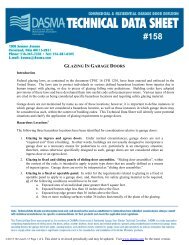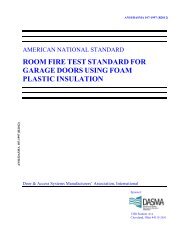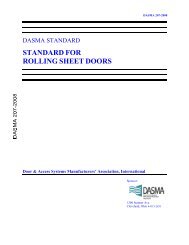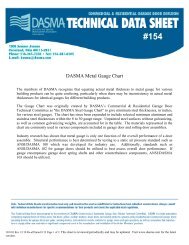Read on - DASMA Door and Access Systems Manufacturers ...
Read on - DASMA Door and Access Systems Manufacturers ...
Read on - DASMA Door and Access Systems Manufacturers ...
You also want an ePaper? Increase the reach of your titles
YUMPU automatically turns print PDFs into web optimized ePapers that Google loves.
HeadLines Today’s Top News StoriesLead-SafeRequirementsHit theGarage <strong>Door</strong>IndustryHelpfulInformati<strong>on</strong>FromAuthoritativeSourcesBy Tom Wadsworth, Editor36 <strong>Door</strong> & <strong>Access</strong> <strong>Systems</strong> | Summer 2010
“The ten most dangerous words in theEnglish language are, ‘Hi, I’m from thegovernment, <strong>and</strong> I’m here to help.’”—R<strong>on</strong>ald Reagan, July 28, 1988Why All the Fuss?The problems of lead pois<strong>on</strong>ing havebeen publicized for decades. Accordingto the EPA …• “Lead paint pois<strong>on</strong>ing affects over<strong>on</strong>e milli<strong>on</strong> children today.”• “Learning disabilities, hearing loss,<strong>and</strong> violent behavior are some of theeffects lead paint can have <strong>on</strong> youngchildren.”• “Lead may cause a range of healtheffects, from behavioral problems<strong>and</strong> learning disabilities, to seizures<strong>and</strong> death.”• “Lead is more dangerous to children… [but] lead is also harmful toadults. Adults can suffer from:reproductive problems (in both men<strong>and</strong> women), high blood pressure<strong>and</strong> hypertensi<strong>on</strong>, nerve disorders,memory <strong>and</strong> c<strong>on</strong>centrati<strong>on</strong> problems,muscle <strong>and</strong> joint pain.”Editor’s PrefaceSince March 1, we have received comments <strong>and</strong> input from hundreds of garage door dealersthroughout the United States about the Envir<strong>on</strong>mental Protecti<strong>on</strong> Agency’s (EPA) new lead-safework practices. Yes, hundreds.Opini<strong>on</strong>s are clashing. Tempers are flaring. Misinterpretati<strong>on</strong>s are rampant. C<strong>on</strong>fusi<strong>on</strong> <strong>and</strong>frustrati<strong>on</strong> abound.In an attempt to increase clarity <strong>and</strong> provide reliable informati<strong>on</strong>, this article will presentmuch informati<strong>on</strong> taken directly from authoritative sources, primarily from the EPA itself.Knowing that legalese <strong>and</strong> regulati<strong>on</strong>-speak are not always easy to underst<strong>and</strong>, we willoccasi<strong>on</strong>ally translate when we are c<strong>on</strong>fident in our translati<strong>on</strong>.Wherever possible, this article will provide exact quotati<strong>on</strong>s from these sources, avoidingunwarranted interpretati<strong>on</strong>s. To aid the reader, red text in this article indicates the exact wordingof the EPA language as found in the lead-safe practices rule as published in the Federal Register<strong>on</strong> April 22, 2008, <strong>on</strong> the EPA Web site, in current EPA documents, or from EPA authorities inWashingt<strong>on</strong>.This article does not cover all the issues involved. But we hope we are touching some of theissues of urgent interest to U.S. garage door dealers. The reader should also note that changeshave been proposed for certain porti<strong>on</strong>s of the regulati<strong>on</strong>s. Dealers are urged to stay tuned in toreliable sources for updates.<strong>DASMA</strong> has developed a line of communicati<strong>on</strong> to the head of the EPA’s lead paintprogram. An industry lead-paint task force, composed of <strong>DASMA</strong> <strong>and</strong> IDA members, is nowstudying industry questi<strong>on</strong>s <strong>and</strong> working with the EPA to get reliable answers. The group mayhave results to report this summer. To receive e-mail updates <strong>on</strong> this issue, please send youre-mail address to dasma@dasma.com.April 22, 2010: Earth DayOn April 22, 2010, the entire U.S. renovati<strong>on</strong> world, including the garage door industry,received a major wake-up call from the EPA. Effective that date, “no firm may perform, offer, orclaim to perform renovati<strong>on</strong>s without certificati<strong>on</strong> from EPA” in any housing or child-occupiedfacilities c<strong>on</strong>structed prior to 1978.On March 19, in an exclusive interview with <strong>Door</strong> & <strong>Access</strong> <strong>Systems</strong>, Maria J. Doa, Ph.D.,who serves as the director of the EPA’s lead-based paint program, stated that garage doordealers “need to have a trained <strong>and</strong> certified renovator <strong>on</strong> staff, <strong>and</strong> their firm needs to be acertified firm.” Failure to comply can incur a fine of up to $37,500 per violati<strong>on</strong>, per day.The EPA’s Renovati<strong>on</strong>, Repair, <strong>and</strong> Painting (RRP) Rule applies when you work <strong>on</strong>“pre-1978 housing <strong>and</strong> child-occupied facilities, such as schools <strong>and</strong> daycares.” When the ruleapplies, renovators must ensure that all lead dust is properly c<strong>on</strong>tained <strong>and</strong> disposed of. Someexcepti<strong>on</strong>s apply (see p. 42).However, according to the EPA’s Lead-Safe Renovati<strong>on</strong>s booklet published in March 2009,“If a home was built before 1978, you must either assume that lead-based paint is present orhave the work area tested for lead-based paint before starting the job.”Key Task: Get Certified<strong>DASMA</strong> <strong>and</strong> IDA are urging all garage door installati<strong>on</strong>/repair companies to get their firmscertified <strong>and</strong> to have at least <strong>on</strong>e employee from each firm complete the requirements to becomea certified renovator.c<strong>on</strong>tinued <strong>on</strong> page 38<strong>Door</strong> & <strong>Access</strong> <strong>Systems</strong> | Summer 2010 37
c<strong>on</strong>tinued from page 37The EPA says, “To become a certifiedrenovator, individuals are required to takeeight hours of training, of which two hoursmust be h<strong>and</strong>s-<strong>on</strong> training.” Firms becomecertified by submitting “a two-page applicati<strong>on</strong>to EPA <strong>and</strong> pay a fee of $300. Certificati<strong>on</strong> isgood for five years.” Certified firms then earnthe “rights to use EPA’s ‘Lead-Safe CertifiedFirm’ logo.”“Once a dealer is trained <strong>and</strong> certified,they will be better equipped to answer most ofthe questi<strong>on</strong>s that arise,” says Naomi Angel,<strong>DASMA</strong> legal counsel. “Instead of c<strong>on</strong>tinuallyrelying <strong>on</strong> input from others, the trainingwill help each dealer become his or her ownbest resource.”Percentage of Homes Likely to C<strong>on</strong>tain LeadHomes BuiltFrom 1960 – 1978Homes BuiltFrom 1940 – 1959Homes BuiltBefore 194024%protecti<strong>on</strong> specialist who works with Dr. Doain the EPA’s Nati<strong>on</strong>al Program ChemicalsDivisi<strong>on</strong>. He copied Dr. Doa <strong>on</strong> his resp<strong>on</strong>se.In his e-mail, Edmunds noted that thekey issue is “whether the work performed isc<strong>on</strong>sidered ‘minor repair <strong>and</strong> maintenance’ asdefined in the RRP regulati<strong>on</strong>s.”He quoted the EPA definiti<strong>on</strong>. “‘Minorrepair <strong>and</strong> maintenance’ is defined as activities… that disrupt six square feet or less ofpainted surface per room for interior activitiesor 20 square feet or less of painted surfacefor exterior activities … When removingpainted comp<strong>on</strong>ents, or porti<strong>on</strong>s of paintedcomp<strong>on</strong>ents, the entire surface area removed isthe amount of painted surface disturbed.”69%87%Source: Nati<strong>on</strong>al Survey of Lead <strong>and</strong> Allergens in Housing, as cited in 40 CFR Part 745, published April 22, 2008.Disturbing Lead-Based Paint?Since April 22, <strong>Door</strong> & <strong>Access</strong> <strong>Systems</strong>has c<strong>on</strong>ducted two nati<strong>on</strong>wide surveys thatgenerated much input from garage door dealers<strong>on</strong> the issue of lead-safe work practices. Sincethe RRP Rule focuses <strong>on</strong> “renovati<strong>on</strong>, repair,<strong>and</strong> painting activities that disturb lead-basedpaint,” many dealers questi<strong>on</strong>ed why typicalgarage door repair <strong>and</strong> replacement workshould apply.For example, we received about 25comments like these:• “Removing garage doors does not disturbpaint. Do the EPA inspectors underst<strong>and</strong>our industry?”• “The homeowner ‘disturbs lead paint’ withevery opening of the door. This is muchmore ‘disturbing lead paint’ than when weremove the door. How does removing a doortrigger the RRP Rule?”<strong>DASMA</strong>’s Three Questi<strong>on</strong>sRecognizing the potential c<strong>on</strong>fusi<strong>on</strong>, <strong>DASMA</strong>e-mailed three questi<strong>on</strong>s to Dr. Doa of theEPA. The questi<strong>on</strong>s attempted to focus <strong>on</strong>three key activities of garage door technicians.The EPA resp<strong>on</strong>ded <strong>on</strong> April 8 in ane-mail from Marc Edmunds, an envir<strong>on</strong>mental#1: Repair WorkOur first questi<strong>on</strong> asked, “Does a garage doortechnician trigger the rule if the task involvesremoving or installing fasteners in a leadpaintedsurface? (The surface could be a doorsecti<strong>on</strong>, door trim, jamb, header, or ceiling).”We figured that this questi<strong>on</strong> covered mostresidential garage door repair work as well asgarage door opener repairs <strong>and</strong> replacements.When Edmunds resp<strong>on</strong>ded, he did notcharacterize his comments as his pers<strong>on</strong>alinterpretati<strong>on</strong> but called them “EPAResp<strong>on</strong>se.” Here’s the first.“EPA Resp<strong>on</strong>se: The RRP rule does notapply for work that meets the definiti<strong>on</strong> ofminor repair <strong>and</strong> maintenance. Removing orinstalling fasteners may disturb paint but theRRP rule would <strong>on</strong>ly apply if the combinedarea of paint disturbed for the entire renovati<strong>on</strong>does exceeds [sic] the square footage in thedefiniti<strong>on</strong> of minor repair <strong>and</strong> maintenance.”#2: Removing Garage <strong>Door</strong> Secti<strong>on</strong>sOur sec<strong>on</strong>d questi<strong>on</strong> asked if the rule wastriggered when “removing a lead-paintedgarage door secti<strong>on</strong>.” We explained that“Garage doors typically come in four stackedsecti<strong>on</strong>s. After removing fasteners, eachsecti<strong>on</strong> is simply carried away.”“EPA Resp<strong>on</strong>se: If you are <strong>on</strong>ly removingfasteners <strong>and</strong> not disturbing paint <strong>on</strong> the doorsthen the square footage of the doors do not haveto be counted toward the six square feet <strong>and</strong>20 square feet in the definiti<strong>on</strong> of minor repair<strong>and</strong> maintenance.”Since this resp<strong>on</strong>se did not specificallyaddress the issue of carrying the secti<strong>on</strong>s, wesent a follow-up questi<strong>on</strong>. We said:“Yes, we are <strong>on</strong>ly removing fasteners, <strong>and</strong>yes, we believe that we are not ‘disturbing paint<strong>on</strong> the doors.’ However, we ARE carrying thedoors away from the garage <strong>and</strong> loading themin the technician’s service truck. Does that‘carrying process’ count as ‘disturbing paint <strong>on</strong>the doors’? Comm<strong>on</strong> sense tells us that this isnot disturbing the paint, but we want to be sure.This acti<strong>on</strong> is repeated thous<strong>and</strong>s of times a dayin our industry.”“It Depends …”His resp<strong>on</strong>se was, “There may be someinstances where removing a door could disturbthe paint. For example, if the paint is in badc<strong>on</strong>diti<strong>on</strong> <strong>and</strong> paint chips fall off the doorwhen it is taken off the hinges or carried, thenthat would be c<strong>on</strong>sidered disturbing paint. Itdepends <strong>on</strong> the situati<strong>on</strong>.”We felt this resp<strong>on</strong>se was encouraging, butthe phrases “there may be some instances” <strong>and</strong>“it depends” leave room for doubt. In a typical35-year-old painted garage door, the surfacesof the secti<strong>on</strong> joints can be rather brittle <strong>and</strong>dusty from c<strong>on</strong>stant rubbing against theadjacent secti<strong>on</strong>.In a later <strong>DASMA</strong> communicati<strong>on</strong> withMarc Edmunds, he acknowledged that garagedoor removal may not be c<strong>on</strong>sidered a typicalhome renovati<strong>on</strong>. But he added, “Removing adoor may or may not disturb paint. It depends<strong>on</strong> the job <strong>and</strong> thus will be a judgment call bythe people working <strong>on</strong> that job.”EPA Posts an Answer OnlineOn May 21, the EPA posted an answer <strong>on</strong> itsWeb site to a specific questi<strong>on</strong> about replacinggarage doors. The posted questi<strong>on</strong> is, “My firmreplaces garage doors. We unbolt the door fromits hardware <strong>and</strong> remove it without penetrating,scraping, or removing paint. Is this work subjectto the RRP Rule?”The EPA’s answer, available for viewing<strong>on</strong>line, is, “If unbolting <strong>and</strong> removing the doordoes not disturb a painted surface in the hinges,door, or frame, the RRP Rule does not apply.”The statement can be found at http://toxics.custhelp.com <strong>and</strong> searching for “garage.” TheAnswer ID number is 6982.c<strong>on</strong>tinued <strong>on</strong> page 4038 <strong>Door</strong> & <strong>Access</strong> <strong>Systems</strong> | Summer 2010
Subscribe to the D&AS Insider<strong>and</strong> Get Your FREELead Paint Digital Fact Sheet.Just send your email address to dasma@dasma.com <strong>and</strong> you will receive:1. Our FREE “Top 12 Links” digital fact sheet. These links, selectedby our editor, take you directly to must-have authoritative informati<strong>on</strong> aboutEPA lead-safe practices.2. A FREE subscripti<strong>on</strong> to the D&AS Insider, delivered directly toyour emailbox four times a year—with special b<strong>on</strong>us issues wheneverurgent news breaks!www.dasma.com
c<strong>on</strong>tinued from page 38#3: Removing Garage <strong>Door</strong> TrimOur third questi<strong>on</strong> asked if we would triggerthe rule by removing lead-painted trim fromthe garage door exterior. We explained, “Theexterior trim is usually pried off. Its total squarefootage is typically less than eight square feet.”“EPA Resp<strong>on</strong>se: The removal of paintedtrim would be c<strong>on</strong>sidered disturbing paint<strong>and</strong> would have to be counted toward thesquare footage of the minor repair <strong>and</strong>maintenance definiti<strong>on</strong>.”Judging by these EPA statements, it appearsthat most garage door repair work will nottrigger the rule unless the total square footageexceeds “the six square feet [interior] <strong>and</strong> 20square feet [exterior] in the definiti<strong>on</strong> of minorrepair <strong>and</strong> maintenance.”Garage door work that doesn’t triggerthe rule, then, likely includes minor tasks suchas changing springs, rollers, <strong>and</strong> hinges, as wellas any opener repair or opener replacements.Replacing a single exterior painted secti<strong>on</strong>would not trigger the rule if its total exteriorsquare footage is less than the 20-sq.-ft.definiti<strong>on</strong>.“Better Safe Than Sorry”So, the big questi<strong>on</strong> involves replacing an entiregarage door that has lead-based paint. Since theEPA’s statements leave open the possibility forliability, door dealers may do well to take thec<strong>on</strong>servative approach. That means focusing <strong>on</strong>safety for the customer, for your workers, <strong>and</strong>for your business.A key statement in the definiti<strong>on</strong> of minorrepair <strong>and</strong> maintenance is, “When removingpainted comp<strong>on</strong>ents, or porti<strong>on</strong>s of paintedcomp<strong>on</strong>ents, the entire surface area removedis the amount of painted surface disturbed.”This statement may be enough to motivate doordealers to regard all replacements of lead-basedpaintedgarage doors as requiring the EPA’slead-safe work practices.EPA Enforcement <strong>and</strong> PenaltiesSeveral door dealers have asked how the EPAintends to enforce the RRP Rule. In its “SmallEntity Compliance Guide to Renovate Right,”the EPA states that it “uses a variety of methodsto determine whether businesses are complying,including inspecting work sites, reviewingrecords <strong>and</strong> reports, <strong>and</strong> resp<strong>on</strong>ding to citizentips <strong>and</strong> complaints.”The “citizen tips <strong>and</strong> complaints,” likelycoming from competitors, may ultimately be theprimary way that the EPA discovers violati<strong>on</strong>s.What can the EPA do to violators? Inadditi<strong>on</strong> to penalties of up to $37,500 perviolati<strong>on</strong>, per day, the EPA can also seek “jailtime for a firm that knowingly <strong>and</strong> willfullyviolates the [RRP Rule] requirements.”Bey<strong>on</strong>d the fines <strong>and</strong> impris<strong>on</strong>ment,“EPA may suspend, revoke, or modify anindividual’s certificati<strong>on</strong> if the individual failsto comply with federal lead-based paint statutesor regulati<strong>on</strong>s.”EPA Year One: Compliance AssistanceWe were informed of a rumor that the EPA has16,000 enforcement officers ready to slap fines<strong>on</strong> n<strong>on</strong>-compliant renovators. However, Dr.Doa told us that this was false.“In the first year, we’re focusing <strong>on</strong>compliance assistance,” said Doa. “We want toget people trained <strong>and</strong> certified.”Passing Resp<strong>on</strong>sibility?Some dealers have stated that they plan tosidestep the requirements by hiring anothercompany to remove any lead-painted garagedoors. The door dealer would then come in <strong>and</strong>install a new door in an empty opening, withoutdisturbing any paint.This approach, however, will not relieveyou of liability. “If you hire some<strong>on</strong>e to dowork for you, you are resp<strong>on</strong>sible for theirwork,” says Naomi Angel.Four Excepti<strong>on</strong>s Become Three:Opt-Out Is OutThe original RRP Rule offered four ways thatrenovators could be exempt from the rule’srequirements. When first introduced in April2008, the RRP Rule c<strong>on</strong>tained an opt-outprovisi<strong>on</strong>. If a homeowner certified that nochild under age six or pregnant women residedin the home, then the renovator would beexempt from the training <strong>and</strong> work practicerequirements of the rule.However, <strong>on</strong> Oct. 28, 2009, theEPA proposed eliminating the opt-outprovisi<strong>on</strong>. This proposed rule became final<strong>on</strong> April 23, 2010. If new legislati<strong>on</strong> doesn'tchange that date, <strong>on</strong>ly three excepti<strong>on</strong>s willthen apply.The Three Excepti<strong>on</strong>s:#1 Lead-Free Projects as Determinedby TestingThe RRP Rule “exempts renovati<strong>on</strong>s that affect<strong>on</strong>ly comp<strong>on</strong>ents that a certified renovator,using a test kit recognized by EPA, determinesare free of lead-based paint.” This opti<strong>on</strong> canbe useful since <strong>on</strong>ly 24 percent of homes builtA Brief History of Lead-Based Paint <strong>and</strong> the U.S. Government1977 Sept. 1: C<strong>on</strong>gress enacts a C<strong>on</strong>sumer Product Safety Act that bans“lead-c<strong>on</strong>taining paint,” effective Feb. 27, 1978.1992 Oct. 28: C<strong>on</strong>gress enacts the Residential Lead-Based Paint HazardReducti<strong>on</strong> Act of 1992, establishing a nati<strong>on</strong>al goal of eliminating leadbasedpaint hazards in housing as expeditiously as possible.1996 Aug. 29: The EPA promulgates its final Lead-Based Paint ActivitiesRegulati<strong>on</strong>s under the Toxic Substances C<strong>on</strong>trol Act (TSCA) Secti<strong>on</strong> 402(a) for pre-1978 housing <strong>and</strong> child-occupied facilities.1998 June 1: EPA regulati<strong>on</strong>s require pers<strong>on</strong>s who perform renovati<strong>on</strong>s forcompensati<strong>on</strong> in target housing to provide a lead hazard informati<strong>on</strong>pamphlet to owners <strong>and</strong> occupants of the home being renovated.2006 Jan. 10: The EPA issues a Notice of Proposed Rulemaking coveringrenovati<strong>on</strong> performed for compensati<strong>on</strong> in target housing. The proposalc<strong>on</strong>tains requirements designed to address lead-based paint hazardscreated by renovati<strong>on</strong>, repair, <strong>and</strong> painting activities that disturb leadbasedpaint.2007 June 5: The EPA issues a Supplemental Proposal to add childoccupiedfacilities to the buildings covered by the 2006 Proposal.2008 April 22: The EPA publishes the final rule c<strong>on</strong>cerning the Renovati<strong>on</strong>,Repair, <strong>and</strong> Painting (RRP) Program to address the lead hazards inhomes <strong>and</strong> child-occupied facilities. The rule takes effect <strong>on</strong> June 23,2008, with certain segments to be implemented at later dates.2009 Oct. 22: The EPA begins certifying renovati<strong>on</strong> firms.Oct. 28: The EPA publishes a proposed rule to eliminate the “opt-outprovisi<strong>on</strong>” that allows a homeowner to exempt a renovati<strong>on</strong> firm fromthe RRP rule by certifying that no child under age six or pregnantwomen reside in the home.2010 April 22: The RRP Rule of 2008 is fully implemented, prohibiting firmsfrom performing renovati<strong>on</strong>s <strong>on</strong> target buildings without certificati<strong>on</strong>from EPA.May 6: The EPA publishes a final rule to eliminate the “opt-outprovisi<strong>on</strong>” that was created in 2008. The opt-out provisi<strong>on</strong> is set foreliminati<strong>on</strong> <strong>on</strong> July 6, 2010.40 <strong>Door</strong> & <strong>Access</strong> <strong>Systems</strong> | Summer 2010
from 1960 to 1978 are likely to c<strong>on</strong>tain leadbasedpaint.All comp<strong>on</strong>ents affected must be tested.If, for example, you are planning to replace agarage door <strong>and</strong> trim, “the certified renovatormust test each of the comp<strong>on</strong>ents that will beaffected by the renovati<strong>on</strong>.” Thus, the garagedoor <strong>and</strong> the trim must be tested.According to the RRP Rule, the <strong>on</strong>lyexcepti<strong>on</strong> to testing all comp<strong>on</strong>ents is when“the comp<strong>on</strong>ents make up an integrated whole,such as the individual stair treads <strong>and</strong> risers ina staircase. In this situati<strong>on</strong>, the renovator needtest <strong>on</strong>ly <strong>on</strong>e such individual comp<strong>on</strong>ent, e.g.,a single stair tread, unless it is obvious to therenovator that the individual comp<strong>on</strong>ents havebeen repainted or refinished separately.”Only One EPA-Recognized KitThe tests are simple <strong>and</strong> inexpensive. Asof June 10, 2010, the <strong>on</strong>ly two EPA-recognizedtest kits are “the LeadCheck kit <strong>and</strong> theState of Massachusetts kit.” Of these,LeadCheck appears to be the <strong>on</strong>ly commerciallyavailable product.On April 9, Mike Per<strong>on</strong>i, the chief operatingofficer of Hybrivet <strong>Systems</strong>, the maker ofLeadCheck, told us that his firm had just sentits first shipment to Sherwin Williams stores.But by May 18, Per<strong>on</strong>i reported that the kitswere available at other stores such as SherwinWilliams, Do It Best, Modern Builders Supply,ABC Supply, Home Depot, <strong>and</strong> Lowes.D<strong>on</strong>’t Get the Wr<strong>on</strong>g KitSome stores may have a c<strong>on</strong>sumer versi<strong>on</strong> ofLeadCheck, such as <strong>on</strong>e marketed by Homax,that does not include the test c<strong>on</strong>firmati<strong>on</strong> cards.These cards are essential for certified renovatorsto provide a record the test results.Per<strong>on</strong>i says LeadCheck has severed itsrelati<strong>on</strong>ship with Homax. If you find any kitssold under the Homax label, they are the finalremnants of Homax’s inventory. Many otherbr<strong>and</strong>s of test kits are available <strong>on</strong> Amaz<strong>on</strong><strong>and</strong> elsewhere, but LeadCheck—with the testc<strong>on</strong>firmati<strong>on</strong> card—is the <strong>on</strong>ly EPA-recognizedkit available.Having a corner in a hot market is a goodplace to be, but it has its struggles. “A lot ofn<strong>on</strong>-c<strong>on</strong>tractors have bought our swabs <strong>and</strong> areselling them <strong>on</strong> eBay for ridiculous prices,”Per<strong>on</strong>i warns.How to OrderKits can be ordered directly from LeadCheckfor $2.15 per test swab by calling 508-651-7881 or 800-262-5323. Currently, the kits areavailable <strong>on</strong>line <strong>on</strong>ly from check4lead.com <strong>and</strong>homedepot.com, but <strong>on</strong>line prices are higher.In resp<strong>on</strong>se to high dem<strong>and</strong>, Per<strong>on</strong>i saysthe company has ramped up producti<strong>on</strong> <strong>and</strong>extended its call center hours to 7:00 a.m. to8:00 p.m. (ET). Still, lead times in late Maywere two <strong>and</strong> a half to three weeks.He recognizes that many renovators haveprojects right now, but can’t get the test kits.“The best soluti<strong>on</strong> is to assume there is lead <strong>and</strong>proceed accordingly,” he adds.The Three Excepti<strong>on</strong>s#2 Minor Repair <strong>and</strong> MaintenanceAs stated earlier, “the RRP rule does not applyfor work that meets the definiti<strong>on</strong> of minorrepair <strong>and</strong> maintenance.” This means activities“that disrupt six square feet or less of paintedsurface per room for interior activities or20 square feet or less of painted surface forexterior activities.”But as noted previously, “When removingpainted comp<strong>on</strong>ents, or porti<strong>on</strong>s of paintedcomp<strong>on</strong>ents, the entire surface area removed isthe amount of painted surface disturbed.”The Three Excepti<strong>on</strong>s#3 Emergency ProjectsEmergency projects are also an excepti<strong>on</strong>,but not entirely. “Emergency projects areexempt from the lead hazard informati<strong>on</strong>distributi<strong>on</strong> requirements, but the clean-up afterthe project must meet the requirements of thisregulati<strong>on</strong>, <strong>and</strong> compliance with the training,certificati<strong>on</strong>, warning sign, <strong>and</strong> c<strong>on</strong>tainmentrequirements of this regulati<strong>on</strong> is required to theextent practicable.”The 2008 published rule doesn’t providemuch clarity to the definiti<strong>on</strong> of “emergencyprojects.” It does say, however, “Emergencyrenovati<strong>on</strong>s include interim c<strong>on</strong>trols performedin resp<strong>on</strong>se to a resident child with an elevatedblood-lead level.”The EPA’s “Small Entity ComplianceGuide to Renovate Right” (December2008 editi<strong>on</strong>), offers a helpful definiti<strong>on</strong> of“emergency renovati<strong>on</strong>.” It identifies it as“Unplanned renovati<strong>on</strong> activities d<strong>on</strong>e inresp<strong>on</strong>se to a sudden, unexpected event which,if not immediately attended to, presents a safetyor public health hazard or threatens propertywith significant damage.”The Disposal IssueSeveral garage door dealers, even some whohave taken the training, have asked questi<strong>on</strong>sabout the proper disposal of a garage door withlead-based paint. The EPA documents are fairlyclear about disposal issues.The EPA’s “Steps to Lead Safe Renovati<strong>on</strong>,Repair <strong>and</strong> Painting” brochure of March 2009says, “Use heavy plastic sheeting or bags tocollect waste. Large comp<strong>on</strong>ents should bewrapped in protective sheeting <strong>and</strong> sealed(securely) with tape.”The “Small Entity Compliance Guide”adds that the sealing must be secure enough to“prevent releases of dust <strong>and</strong> debris beforethe waste is removed from the work area.”Further, the RRP Rule adds that while“transporting lead-based paint waste from awork site,” you “must c<strong>on</strong>tain the waste toprevent identifiable releases.”A few door dealers have expressed difficultyin finding a l<strong>and</strong>fill that will accept the waste.The “Steps to Lead Safe” brochure says, “Mostwaste generated during these [residentialrenovati<strong>on</strong>] activities is classified as solid,n<strong>on</strong>-hazardous waste, <strong>and</strong> should be taken to alicensed solid waste l<strong>and</strong>fill.”The EPA notes, however, that “Work d<strong>on</strong>ein commercial, public, or other n<strong>on</strong>residentialchild-occupied facilities … may be c<strong>on</strong>sideredhazardous <strong>and</strong> require special disposalmethods.” Since some l<strong>and</strong>fills may be morestringent than federal regulati<strong>on</strong>s, the EPArecommends that you check your state <strong>and</strong>local requirements.Recordkeeping, etc.As stated earlier, this article does not coverevery issue involved in the RRP Rule. Properrecordkeeping, posting of signs, establishingbarriers, distributing informati<strong>on</strong> to occupants,pers<strong>on</strong>al protective equipment, <strong>and</strong> cleaningprocedures, for example, should be coveredadequately in your training. This is anotherreas<strong>on</strong> to take the training <strong>and</strong> take it seriously.The Proposal to DelayPrior to the April 22, 2010, implementati<strong>on</strong>date, several c<strong>on</strong>structi<strong>on</strong> industry associati<strong>on</strong>sappealed for a delay. They claimed that theindustry had not been adequately notified of theRule <strong>and</strong> that states had not been able to trainenough renovators to be in compliance.On April 29, a week after the RRP Rulewas fully implemented, legislati<strong>on</strong> wasintroduced in the U.S. House (H.R. 5177), <strong>and</strong>in the Senate <strong>on</strong> May 4, (S. 3296), to delay theimplementati<strong>on</strong> of the RRP Rule.On May 27, the Senate passed legislati<strong>on</strong>that would bar the EPA from levying finesagainst c<strong>on</strong>tractors through Sept. 30, 2010,<strong>and</strong> give c<strong>on</strong>tractors more time to comply withthe RRP Rule. The amendment, part of anappropriati<strong>on</strong>s bill, must still be approved by theHouse <strong>and</strong> signed by the president. At the timeof this writing, its outcome was not yet final.If the amendment is approved, door dealerswould be saved from any fines if they signc<strong>on</strong>tinued <strong>on</strong> page 42<strong>Door</strong> & <strong>Access</strong> <strong>Systems</strong> | Summer 201041
c<strong>on</strong>tinued from page 41up for the RRP training class by the end ofSeptember.Public <strong>and</strong> CommercialBuildings, Too?On April 23, 2010, the EPA announced itsintenti<strong>on</strong> to exp<strong>and</strong> the RPP Rule bey<strong>on</strong>dpre-1978 housing <strong>and</strong> child-occupied facilities.Specifically, the EPA said it intends “topropose lead-safe work practices <strong>and</strong> otherrequirements for renovati<strong>on</strong>s <strong>on</strong> the exteriorsof public <strong>and</strong> commercial buildings.” TheEPA also plans “to determine whether leadbasedpaint hazards are created by interiorrenovati<strong>on</strong>, repair, <strong>and</strong> painting projects inpublic <strong>and</strong> commercial buildings.”Ultimately, the EPA plans to issue aproposal “to regulate renovati<strong>on</strong>s <strong>on</strong> theexteriors of public <strong>and</strong> commercial buildings… by Dec. 15, 2011, <strong>and</strong> to take final acti<strong>on</strong>… by July 15, 2013.”What does this mean? If your garagedoor firm is planning to ignore certificati<strong>on</strong><strong>and</strong> refuse to do jobs that require RPPlead-safe work practices, you might want torec<strong>on</strong>sider. In the next few years, you may findyourself shut out of many more jobs than justpre-1978 housing.Some States May VaryA state may promulgate its own rules that may be different from or go bey<strong>on</strong>d the federalrequirements. As of June 10, 2010, eight states had been authorized to administer their ownRRP programs in lieu of the federal program. If you live in <strong>on</strong>e of the following states, c<strong>on</strong>tactyour state program about its training <strong>and</strong> certificati<strong>on</strong> requirements.• Iowa (Dept. of Public Health)• Kansas (Dept. of Health <strong>and</strong> Envir<strong>on</strong>ment)• Mississippi (Dept. of Envir<strong>on</strong>mental Quality)• North Carolina (Dept. of Health <strong>and</strong>Human Services)You Can’t Fight City HallJudging from the resp<strong>on</strong>ses of hundreds ofdoor dealers nati<strong>on</strong>wide, it’s clear that manyare frustrated <strong>and</strong> angry with the new lead-safework practices. Our surveys offered dealersthe opti<strong>on</strong> to submit comments, <strong>and</strong> hundredsjumped at the opportunity. Nearly all commentswere negative.For example, dealers criticized the RRPRule as “ridiculous,” “too late <strong>and</strong> too costly,”“corrupt,” “an attack <strong>on</strong> small business,”“n<strong>on</strong>sense,” “just another m<strong>on</strong>ey grab bythe government,” “totally crazy,” “the mostunnecessary regulati<strong>on</strong> ever,” “absurd,”“benefiting <strong>on</strong>ly the tailgater,” <strong>and</strong> “just another• Oreg<strong>on</strong> (Dept. of Human Services,Public Health Divisi<strong>on</strong>)• Rhode Isl<strong>and</strong> (Dept. of Health)• Utah (Dept. of Envir<strong>on</strong>mental Quality)• Wisc<strong>on</strong>sin (Dept. of Health Services)government rip-off.”We admit that we had similar thoughts.But after the initial shock wears away, theregulati<strong>on</strong>s still st<strong>and</strong>.Naomi Angel, <strong>DASMA</strong>’s legal counsel,has been working closely with governmentregulati<strong>on</strong>s for decades. She underst<strong>and</strong>s ourfrustrati<strong>on</strong>, but recognizes that it’s a comm<strong>on</strong><strong>and</strong> recurring reacti<strong>on</strong> in the eternal cycle ofgovernment regulati<strong>on</strong>.“It’s unproductive <strong>and</strong> futile to think thatthe rules are inc<strong>on</strong>sistent or n<strong>on</strong>sensical,” sheadvises. “Just follow the rules as best you can<strong>and</strong> protect yourself from liability.”Serving the Heartl<strong>and</strong> Since 1964GARAGEDOORS“Experience the Quality”Delden Garage <strong>Door</strong>s offers engineered quality whileproviding opti<strong>on</strong>s including different colors, textures, designdetails, heavy duty hardware <strong>and</strong> track accessories. Variousrequirements for job site c<strong>on</strong>diti<strong>on</strong>s dem<strong>and</strong> a full array ofproduct choices. Quality c<strong>on</strong>structi<strong>on</strong> completes theexpectati<strong>on</strong> for the perfect door for the special order.3530 NE Kimball Dr. | Kansas City, MO 64161 | Ph<strong>on</strong>e 816-413-1600 | Fax 816-413-1699 | www.DeldenMfg.com42 <strong>Door</strong> & <strong>Access</strong> <strong>Systems</strong> | Summer 2010



